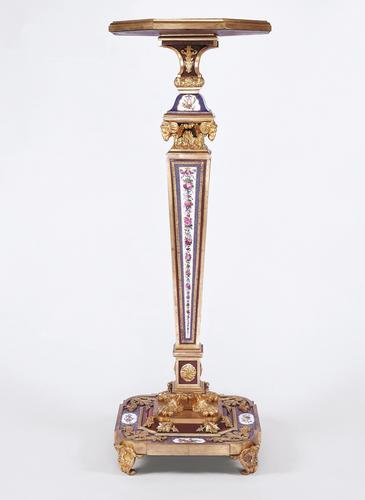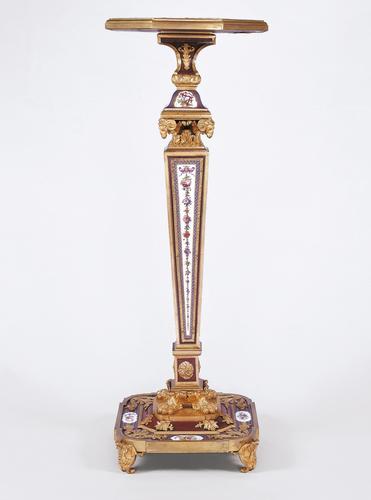Candle stand c 1824
Oak veneered with purplewood, fitted with twelve plaques and one cushion-shaped section, bronze chased and gilt mounts | 111.5 x 43.0 x 43.0 cm (whole object) | RCIN 21691






-
Each candle stand is fitted with twelve plaques and one cushion-shaped section, all of Paris porcelain. The mounts are of bronze chased and gilt. The octagonal top, encased in a chamfered moulding of gilt bronze, is fitted with four porcelain plaques overlain by a pierced gilt bronze membrane chased with foliage. The shaft is divided into registers: at the top is a splayed purplewood support, below which is a gilt bronze moulding chased with foliage and interlacing, which crowns a rounded cushion-like section in porcelain. The tapered shaft, which is inset on each face with a recessed porcelain plaque, is crowned by an incurving acanthus-leaf collar with goats’ heads at the four corners and terminates at the bottom in a pedestal mounted on each face with a rosette raised on foliate bear-paw feet, all in gilt bronze. The stepped base, each step of conforming design, is square in section with recessed rounded corners. The top step is of bronze, the middle step of mahogany with gilt bronze foliate enrichments, and the bottom step panelled in porcelain. The whole rests on four scrolled shield-like feet, S-shaped in profile.
The porcelain is of hard-paste Paris porcelain. The dark blue ground colour is overlaid in gold with trellis patterns of differing design (much worn in parts). The trophies on the cushion-shaped sections vary from reserve to reserve and from pedestal to pedestal. They include emblems of love, pastoral subjects, music and the theatre. The trophies on the bases, emblematic of gardening, music and love, vary from reserve to reserve. The flowers on the plaques include roses, convolvulus, anemones (some double-headed), poppies, auriculas, forget-me-nots, passionflowers, foxgloves, carnations, etc.
George IV probably bought these candle stands as five pairs of which two now remain in the Royal Collection. They were acquired In Paris between 1820 and 1825 and were purchased with the furnishing of Windsor Castle in mind. Two were included in Morel and Seddon’s room designs, dating from c.1826, of the south and west elevations of The Drawing Room at Windsor Castle.
Inscribed on .2, in ink: L.P. Di [?] d[ ], Le 10m Gait Oct 184[?5].
Text adapted from French Porcelain: In the Collection of Her Majesty The Queen, London, 2009Provenance
George IV owned four pairs of torchères of this model. The first and second pairs, acquired in 1820-1 were given to Lady Conyngham; sold Christie's.
These two pairs of candle stands were purchased for George IV by Sir Charles Long (later Lord Farnborough) in Paris in 1824/5 from the Parisian dealer Alexis Delahante for 12,500 francs. Their receipt at Carlton House was recorded on 25 February and 21 June 1825 respectively.
Alexandre-François Bellangé was the son of a well known cabinet maker Louis François Bellangé’s (1759–1827) who supplied furnishings to the Emporer Napoleon and King Louis XVIII. On his father’s retirement Alexandre- François Bellangé took over his workshop.
Alexis Delahante (1767–1837) spent most of the French Revolutionary period as an emigré in England and the Netherlands principally as a dealer in Old Master paintings. On his return to France, after the Bourbon restoration in 1815, he became involved in dealing in furniture and, in particular, trading many pieces of Bellangé furniture.
The two later pairs from the Small Blue Velvet Room, Carlton House; delivered by Morel & Seddon to Windsor for the Boudoir on 24 July 1828; the new gilt wood plinths supplied by them, are now missing.
Part of the group of furniture and furnishings supplied between 1827 and 1829 to King George IV by the partnership of Morel and Seddon for The Drawing Room at Windsor Castle.
Nicholas Morel had formerly worked for The Prince of Wales, later George IV, at Carlton House and the Royal Pavilion at Brighton. Subsequently, he was commissioned to design and furnish the newly built apartments designed by Sir Jeffry Wyattville (1766-1840) for the King at Windsor Castle. In order to fulfil the contract he entered into partnership with George Seddon III whose family had large and long established furniture workshops in Aldersgate Street in the City of London. -
Creator(s)
(cabinet maker)(restorer)(nationality)Acquirer(s)
-
Medium and techniques
Oak veneered with purplewood, fitted with twelve plaques and one cushion-shaped section, bronze chased and gilt mounts
Measurements
111.5 x 43.0 x 43.0 cm (whole object)
Place of Production
Paris [Île-de-France]








